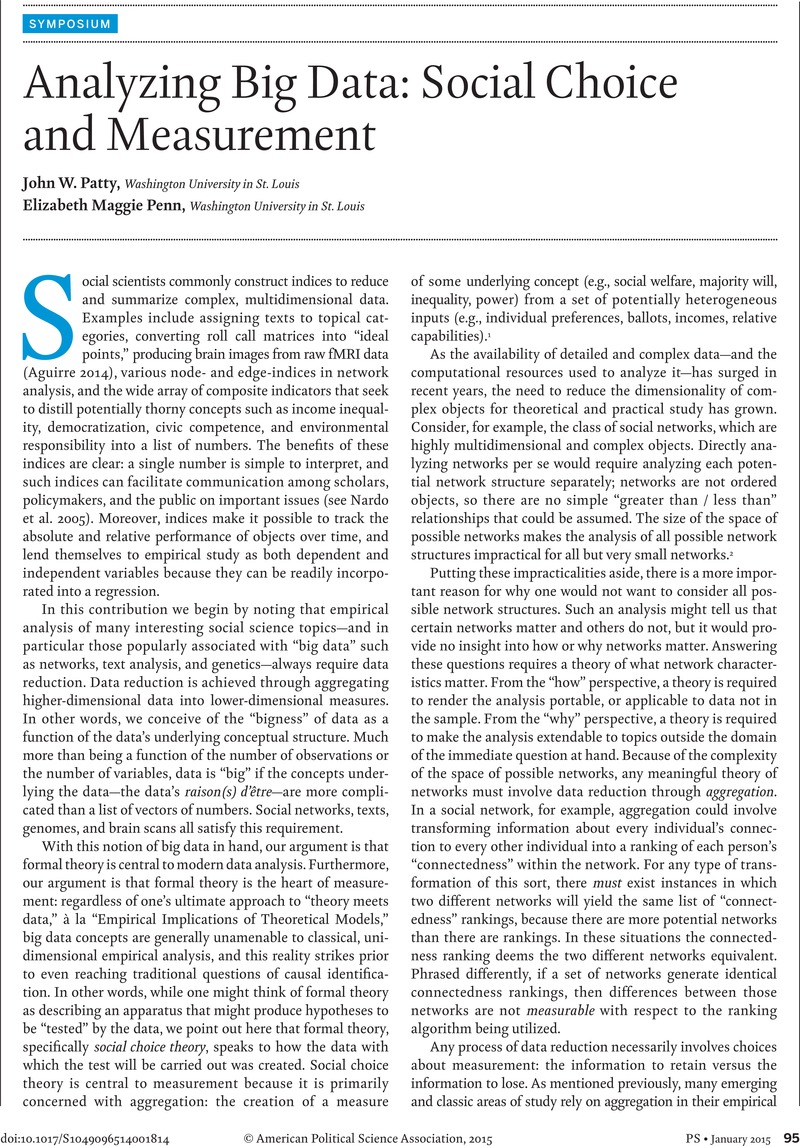Crossref Citations
This article has been cited by the following publications. This list is generated based on data provided by Crossref.
de Souza, R.S.
and
Ciardi, B.
2015.
AMADA—Analysis of multidimensional astronomical datasets.
Astronomy and Computing,
Vol. 12,
Issue. ,
p.
100.
Patty, John W.
and
Penn, Elizabeth Maggie
2015.
Aggregation, Evaluation, and Social Choice Theory.
The Good Society,
Vol. 24,
Issue. 1,
p.
49.
Monteith, Scott
Glenn, Tasha
Geddes, John
and
Bauer, Michael
2015.
Big data are coming to psychiatry: a general introduction.
International Journal of Bipolar Disorders,
Vol. 3,
Issue. 1,
ur Rehman, Muhammad Habib
Liew, Chee Sun
Abbas, Assad
Jayaraman, Prem Prakash
Wah, Teh Ying
and
Khan, Samee U.
2016.
Big Data Reduction Methods: A Survey.
Data Science and Engineering,
Vol. 1,
Issue. 4,
p.
265.
Margetts, Helen
2017.
The Data Science of Politics.
Political Studies Review,
Vol. 15,
Issue. 2,
p.
201.
Habib ur Rehman, Muhammad
Jayaraman, Prem
Malik, Saif
Khan, Atta
and
Medhat Gaber, Mohamed
2017.
RedEdge: A Novel Architecture for Big Data Processing in Mobile Edge Computing Environments.
Journal of Sensor and Actuator Networks,
Vol. 6,
Issue. 3,
p.
17.
Mahrenbach, Laura C.
Mayer, Katja
and
Pfeffer, Jürgen
2018.
Policy visions of big data: views from the Global South.
Third World Quarterly,
Vol. 39,
Issue. 10,
p.
1861.
Sedkaoui, Soraya
2018.
Big Data Analytics in HIV/AIDS Research.
p.
21.
Patty, John W.
and
Penn, Elizabeth Maggie
2019.
Measuring Fairness, Inequality, and Big Data: Social Choice Since Arrow.
Annual Review of Political Science,
Vol. 22,
Issue. 1,
p.
435.
Jain, Kusumlata
and
Mohapatra, Smaranika
2019.
Edge Computing.
p.
51.
Amsalem, Eran
Fogel-Dror, Yair
Shenhav, Shaul R.
and
Sheafer, Tamir
2020.
Fine-Grained Analysis of Diversity Levels in the News.
Communication Methods and Measures,
Vol. 14,
Issue. 4,
p.
266.
Kim, Song-Kyoo Amang
2020.
Toward Compact Data from Big Data.
p.
1.
Lazer, David
Hargittai, Eszter
Freelon, Deen
Gonzalez-Bailon, Sandra
Munger, Kevin
Ognyanova, Katherine
and
Radford, Jason
2021.
Meaningful measures of human society in the twenty-first century.
Nature,
Vol. 595,
Issue. 7866,
p.
189.
Anilkumar Ambore
and
Udaya Rani V
2022.
Analysis of Data Performance that Reduces Resource Utilization Overheads and Increases the Efficiency.
International Journal of Scientific Research in Computer Science, Engineering and Information Technology,
p.
191.
Mumtaz, Zahid
2022.
Informal Social Protection and Poverty.
p.
141.
Sedkaoui, Soraya
2022.
Research Anthology on Big Data Analytics, Architectures, and Applications.
p.
632.
Chen, Yingying
Peng, Zhao
Kim, Sei-Hill
and
Choi, Chang Won
2023.
What We Can Do and Cannot Do with Topic Modeling: A Systematic Review.
Communication Methods and Measures,
Vol. 17,
Issue. 2,
p.
111.
Bhuwania, Pragya
Chen, Jidong
and
Steinebach, Yves
2024.
On Concepts, Analytics, and Statistics in Comparative Policy Studies: An Introduction from the New Section Editors.
Journal of Comparative Policy Analysis: Research and Practice,
Vol. 26,
Issue. 5,
p.
530.
Stark, Philipp
Hasenbein, Lisa
Kasneci, Enkelejda
and
Göllner, Richard
2024.
Gaze-based attention network analysis in a virtual reality classroom.
MethodsX,
Vol. 12,
Issue. ,
p.
102662.



